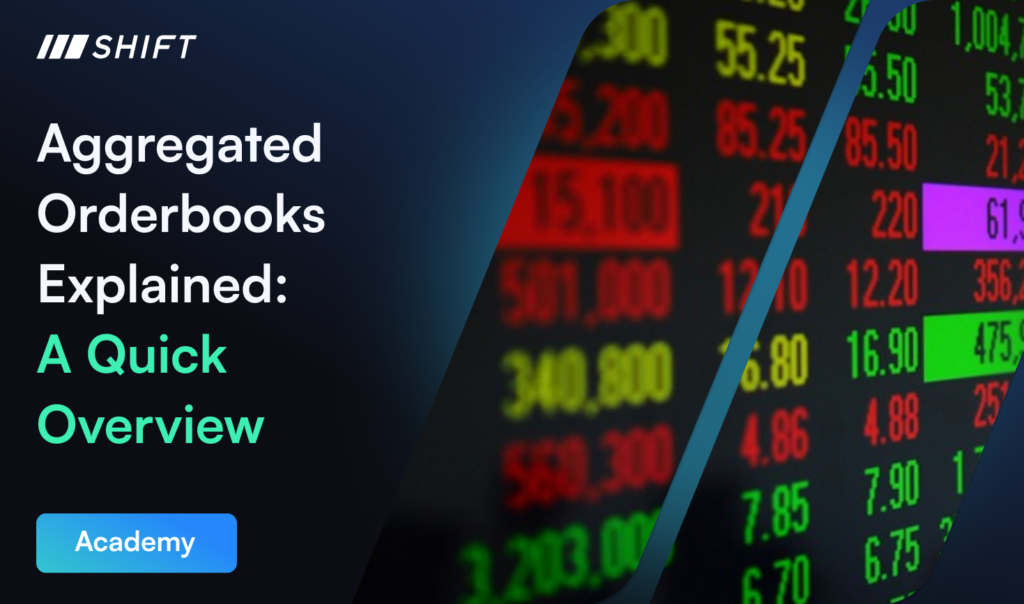Summarize with AI:
An aggregated order book in crypto brings together buy and sell orders from multiple exchanges into a single view, allowing traders to see broader market depth and access better pricing. This benefits traders by reducing costs and improving trade execution, while exchange operators gain a steadier flow of orders and increased liquidity. Aggregated order books make trading smoother and reflect true market activity across platforms.
Aggregated Orderbooks Explained | A Quick Overview
When it comes to crypto trading, pricing and liquidity are everything. As the crypto market grows into 2025, the demand for quick, cost-effective trades has made it essential to access the best prices across multiple exchanges. Aggregated order books solve this by merging buy and sell orders from different platforms into a single, unified view. This gives traders deeper liquidity, lower spreads, and improved execution, all while making it easier to see the true market depth for each asset. In this quick article, we’ll explain how aggregated order books work and why they’ve become a powerful tool in the world of crypto trading.
Understanding Order Books: The Core of Every Crypto Trade
Order books are the foundation of crypto trading, acting as dynamic ledgers that showcase all open buy and sell orders for each asset. Every order represents a trader’s intent, either to purchase at a particular price (bids) or to sell (asks), organized from the most competitive to the least. This structure provides a real-time snapshot of market supply and demand, allowing traders to make informed decisions based on the prices other buyers and sellers are offering. The difference between the highest bid and the lowest ask, known as the bid-ask spread, is a direct reflection of the market’s liquidity.
On a crypto exchange, the order book feeds directly into the platform’s matching engine, which is responsible for executing trades. When a new order is placed, the engine instantly scans the order book to match it with the best available price. If no immediate match is found, the order remains on the book, awaiting a counterparty. This process repeats continuously, updating the order book in real time and ensuring efficient, transparent trades. However, since liquidity can be spread thinly across exchanges, single-exchange order books can only show a partial view of the market’s activity, leaving room for innovations like aggregated order books to improve trade outcomes.
Aggregated Order Books vs. Standard Order Books
Unlike standard order books, which only show orders on a single exchange, aggregated order books combine data from multiple platforms, creating a comprehensive view of the market. This multi-exchange approach means that instead of being limited to one source’s buy and sell orders, traders see a unified list of bids and asks from across the ecosystem. This depth allows for better price visibility and more trading options, as the consolidated data provides access to a broader range of prices at each level.
Aggregated order books also offer tighter bid-ask spreads and improved liquidity, making it easier to execute larger trades without substantial price impact. Standard order books often show larger spreads and can lack the necessary liquidity, especially on smaller exchanges. Aggregation directly addresses this limitation by connecting multiple sources, helping traders get the best prices available while reducing the risks and costs associated with single-platform trading. In short, aggregated order books bring more efficiency, liquidity, and pricing power to every trade.

Traditional orderbooks limit you to the liquidity and pricing of a single exchange, resulting in wider spreads and higher trading costs. Aggregated orderbooks pool multiple exchanges into one view, giving traders access to deeper liquidity, better pricing, and smarter execution – effectively creating a unified global market for every asset.
How Aggregated Order Books Combine Liquidity Across Multiple Sources
Aggregated order books function by pulling data from various exchanges and liquidity providers, combining all available buy and sell orders into one unified feed. This process involves multiple steps, each carefully designed to ensure that the combined view is accurate, up-to-date, and actionable for traders. Aggregators continuously monitor the order books of each integrated exchange, capturing all incoming orders and any changes in real time. This requires high-speed data synchronization, as even slight delays could impact the accuracy of prices and lead to missed trading opportunities.
Once the data is captured, the aggregator’s system organizes orders from each source by price level. In doing so, it eliminates duplicates, removes any inconsistencies, and recalculates the bid-ask spread across the combined liquidity pool. Orders at the best available prices are shown at the top, creating a “best of market” view that allows traders to execute orders at the most favorable rates.
In practice, this means that if Exchange A has the best buy price, Exchange B has the next best, and Exchange C offers the lowest sell price, these orders appear in order, regardless of their originating platform. The aggregator also typically integrates smart order routing, which ensures that orders are split or routed to the exchange with the best price and liquidity. This combination of sources doesn’t just broaden liquidity; it transforms the trading experience by enabling smoother execution, lower costs, and higher accuracy in fast-moving markets.
In this visualization, we can see how an aggregated orderbook brings together pricing and volume from multiple exchanges (shown in blue) into a single source (shown in green). Each exchange broadcasts their best bid and ask prices along with available volume, which flows continuously into the central aggregator. The aggregator then combines this information to create the most competitive pricing possible – in this example, finding the best bid at $42,350 and best ask at $42,400, creating a tight $50 spread. This process happens in real-time, ensuring traders always see the true best prices available across the entire market rather than being limited to a single exchange’s liquidity.
Pooling Liquidity: How Aggregated Order Books Benefit Traders and Exchanges
The pooling of liquidity through aggregated order books offers unique advantages to both traders and exchanges. For traders, access to pooled liquidity means they can see a larger volume of buy and sell orders at each price level, allowing for smoother trade execution with minimal impact on prices. This approach brings tighter bid-ask spreads, helping traders lower transaction costs and obtain the best available prices. By pulling orders from multiple sources, aggregated order books make it easier for traders to complete trades without excessive fluctuations in price.
Exchanges benefit from pooled liquidity by attracting a more diverse range of traders, including those who value deeper liquidity for executing higher volumes. A more active order book can increase trading volume, providing a consistent flow of orders and making the exchange a competitive choice for users. When exchanges collaborate to share liquidity, they contribute to a stable market environment that reduces the volatility often caused by limited orders. This setup is mutually beneficial, supporting both smooth trading for users and stronger performance for the exchange itself.
Conclusion
Aggregated order books are changing the face of crypto trading by bringing together liquidity from multiple exchanges in one place. This approach allows traders to access better pricing, smoother execution, and broader market depth, while exchanges benefit from increased trading activity and a steadier market. As we move into 2025, aggregated order books present an efficient method for capturing the best trading opportunities across platforms.
Shift Markets’ white label crypto market making platform is built to harness the power of aggregated order books, providing clients with deep liquidity, competitive pricing, and advanced trade execution. Designed for simple integration, the Shift Platform equips exchanges with the tools they need to thrive in today’s fast-paced market. Reach out today to learn more.
Share this article:
Want to learn more?
Let us save you time by walking you through what Shift can do for your business!



